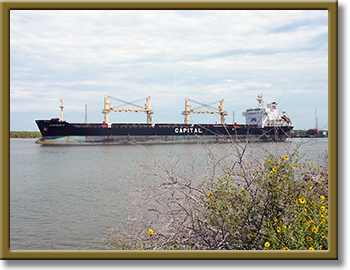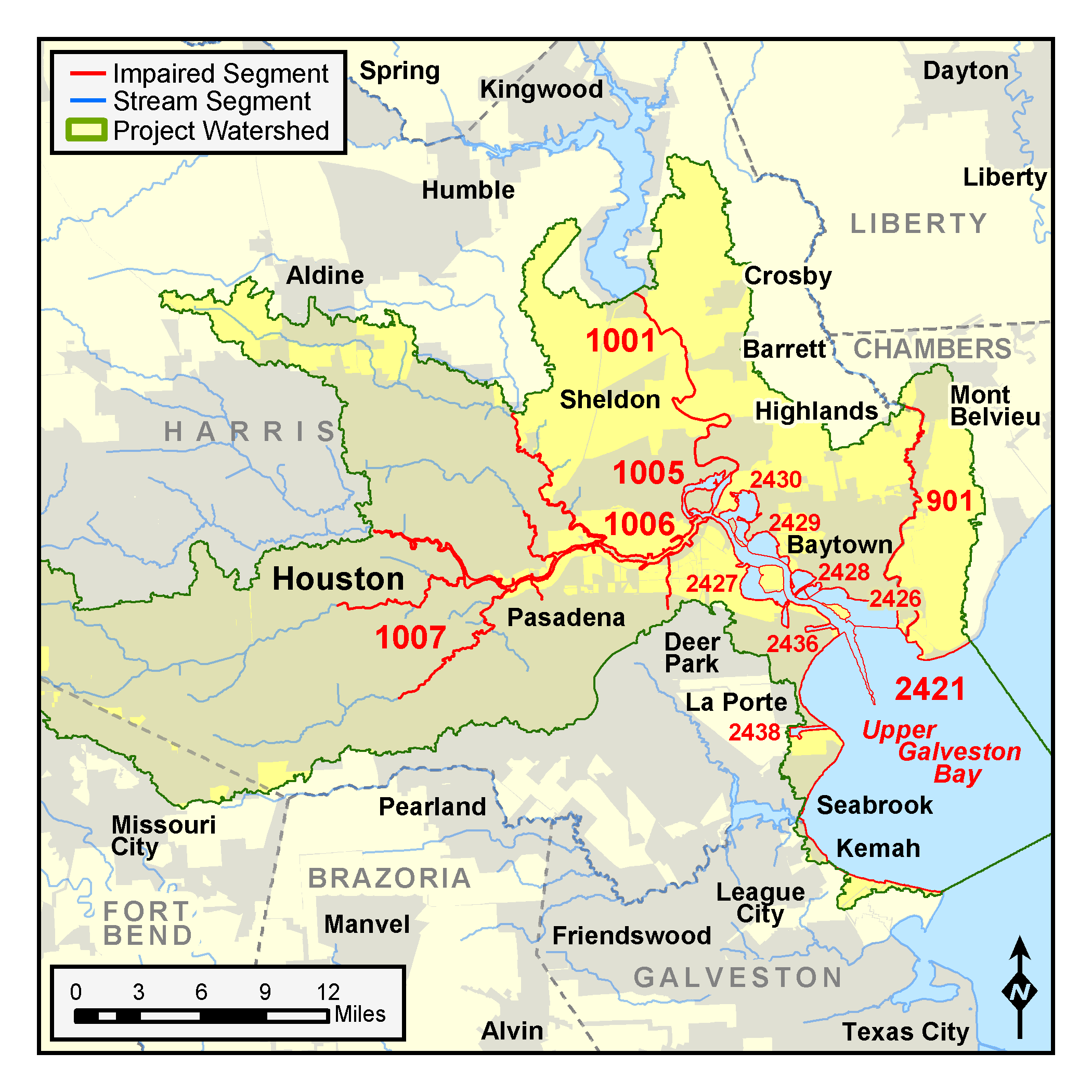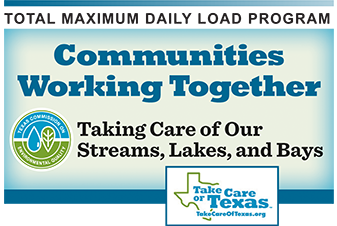Houston Ship Channel and Galveston Bay: Dioxin
This is a completed project that assessed sources of contamination in fish from dioxin and evaluated whether TMDLs were the best option for reducing them.
Counties: Galveston, Harris
Parameter: Dioxin
Basins: Bays and Estuaries, San Jacinto River, Trinity-San Jacinto Coastal Basin
Segments: 0901, 1001, 1005, 1006, 1007, 2421, 2425, 2426, 2427, 2428, 2429, 2430, 2436, 2438
On this page:
- Background and Goals
- Watershed Description
- Public Participation
- Project Documents
- For More Information
Background and Goals
The Houston Ship Channel System consists of 14 designated segments, which together comprise the "enclosed" portion of the Houston Ship Channel proper with its major tributaries and side bays. This project included ten of the designated Houston Ship Channel System segments.
The Texas Department of State Health Services (DSHS) advises that consumers restrict their consumption of catfish and blue crab caught in the Houston Ship Channel because dioxin concentrations in the fish pose a risk to consumers. Dioxin is a generic term for a suite of toxic and environmentally persistent compounds. Overexposure to dioxin can cause a variety of harmful health problems, including cancer, birth defects, diabetes, developmental delays, and immune system abnormalities. More information about the consumption advisory is available in Advisory 55 on the DSHS website .
The goal of this project was to evaluate options for reducing contaminant concentrations in fish tissue to levels that are an acceptable risk to consumers.
TCEQ has also completed two other closely related assessments for area waters: Houston Ship Channel and Galveston Bay PCBs Project and the Galveston Bay Survey of Dioxin and PCBs.
Watershed Description
The Ship Channel system is in the San Jacinto River Basin. Its various branches originate in western and northern areas of the city of Houston, and at the Lake Houston Dam on the San Jacinto River. The Ship Channel area has one of the highest densities of petrochemical facilities in the world. Facilities in the area, and the waterway itself, are important elements in the economic health of the region, state, and nation.
Houston has long been one of the busiest ports in the United States. The channel’s production of materials and its inland location have been, and will continue to be, important to the military security of the nation.
The commercial navigation provided by the channel initiated and supported the historic growth of the Houston area economy. The headwater reaches, tributaries, and fringes of both the Houston Ship Channel System and Upper Galveston Bay provide recreational opportunities for residents.
The watershed includes portions of the following political jurisdictions: Chambers, Fort Bend, Galveston, and Harris counties, and the cities of Houston, Pasadena, Baytown, La Porte, and Deer Park.
The Houston Ship Channel system consists of 14 classified segments, which together comprise the “enclosed” portion of the Houston Ship Channel with its major tributaries and side bays.
This project includes ten of the ship-channel segments:
- San Jacinto River Tidal (1001)
- Houston Ship Channel (1005, 1006, 1007)
- Tabbs Bay (2426)
- San Jacinto Bay (2427)
- Black Duck Bay (2428)
- Scott Bay (2429)
- Burnett Bay (2430)
- Barbours Cut (2436)
Also included are four segments not considered part of the Houston Ship Channel system:
- Cedar Bayou Tidal (Segment 0901)
- Upper Galveston Bay (Segment 2421)
- Bayport Channel (Segment 2438)
- Clear Lake (Segment 2425)
Public Participation
The Houston-Galveston Area Council led a stakeholder group to work on this and two other closely related projects for PCBs and dioxin in the Houston–Galveston area. The group included area residents and representatives of nongovernmental organizations, industry, and various local, state, and federal governments.
H-GAC also coordinated participation, as needed, with the Texas Clean Rivers Program Steering Committee and the Technical Advisory Group (TAG) for the San Jacinto River Basin and associated coastal basins.
Project Documents
Final Report
Data Report
The main Data Report file contains, summarizes, and discusses the data collected to support the TMDL project. The Appendixes file has data in electronic format (Excel spreadsheets or Access database files), in folders corresponding to the appendixes described in the Data Report. Most of the stream data for water, sediment, and tissue are also in the TCEQ SWQMIS database; air, runoff, and effluent data are not.
- Dioxin: Data Report (14.1 MB)
 Dioxin: Appendixes (7.4 MB)
Dioxin: Appendixes (7.4 MB)
Technical Support Documents
The following files document how the modeling was done and how the load allocation was derived from model output.
- Modeling Report (5.1 MB)
- Load Allocation Report (1.4 MB)
Annual Summaries of Findings and Progress
These documents compile quarterly reports from the project. Each summarizes activities during a fiscal year (September - August). Appendixes are not included with these links, but may be requested from the TCEQ TMDL Program Team. Summaries and information from years prior to FY2005 are also available by request.
- Summary of September 2004 - August 2005 (31.9 MB)
- Summary of September 2005 - August 2006 Appendix A of this document is the data summary compilation linked separately above. (3.1 MB)
- Summary of September 2006 - May 2007 (2.7 MB)
Presentations at Public Meetings
These slide shows were used at several public meetings during 2005 through 2007. They summarize project findings and progress, in a less dense and detailed format than the progress reports. Any target values or load allocations shown in these slides were preliminary results subject to change as analyses were refined. Additional presentations and documentation of stakeholder meetings are available on the Houston-Galveston Area Council's Houston Ship Channel dioxin project webpage .
- February 2005 Stakeholder Meeting Presentation (1.4 MB)
- September 2006 Stakeholder Meeting Presentation (0.9 MB)
- April 2007 Stakeholder Meeting Presentation (1.4 MB)
- June 2007 Stakeholder Meeting Presentation (0.2 MB)
For More Information
Please email tmdl@tceq.texas.gov and mention the Houston Ship Channel Dioxin project in the subject line. Or call us at 512-239-6682.





